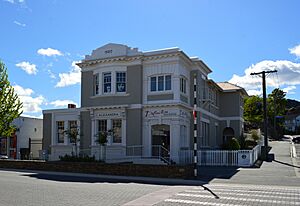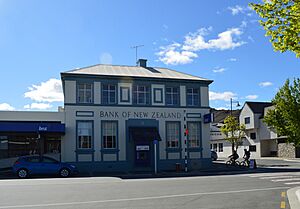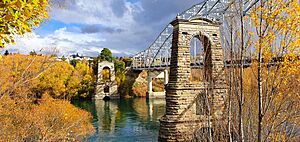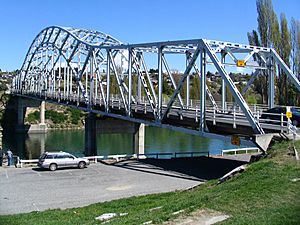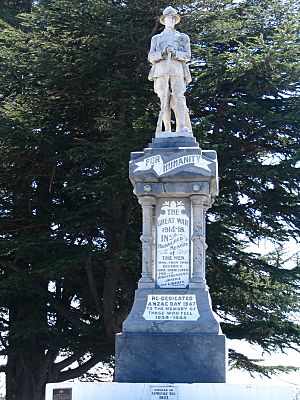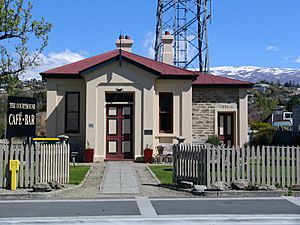Alexandra, New Zealand facts for kids
Quick facts for kids
Alexandra
Manuherikia or Areketanara (Māori)
|
|
|---|---|
|
Minor urban area
|
|

Skyline of Alexandra in May 2022
|
|
| Country | New Zealand |
| Region | Otago |
| Territorial authority | Central Otago District |
| Ward | Vincent Ward |
| Community | Vincent Community |
| Electorates |
|
| Area | |
| • Total | 9.76 km2 (3.77 sq mi) |
| Elevation | 150 m (490 ft) |
| Population
(June 2023)
|
|
| • Total | 6,120 |
| • Density | 627.0/km2 (1,624.0/sq mi) |
| Postcode |
9320
|
| Local iwi | Ngāi Tahu |
Alexandra is a town in the Central Otago region of New Zealand's South Island. It sits by the Clutha River, where the Manuherikia River joins it. You can find Alexandra on State Highway 8. It is about 188 kilometres from Dunedin. The town is also 33 kilometres south of Cromwell.
Alexandra is home to about 6,120 people as of June 2023. .
Contents
History of Alexandra
How Alexandra Began
Alexandra was founded in the 1860s during the Otago gold rush. It was named after Alexandra of Denmark. In 1862, two gold miners, Horatio Hartley and Christopher Reilly, found a lot of gold in the Cromwell Gorge. They kept it secret at first. But to get a reward from the government, they told everyone about their discovery.
This made the Clutha River famous for its gold. Soon, about 2000 miners came to Alexandra. Many early miners were Chinese, making up about half of the mining population. A gold dredge called the Lady Molyneux once collected 1234 ounces of gold in just one week! Gold mining in the Clutha River was dangerous. In 1863, 37 men drowned there.
Gold Mining Changes
By 1889, most of the easy gold was gone. People started growing fruit instead. When the river ran out of gold, people used 'paddock dredging' to find gold on the river banks. This noisy work happened day and night between 1896 and 1924, and again from 1951 to 1963. It also created a lot of dust. The leftover piles of rock from dredging now cover 170 hectares. This area is called the Earnscleugh Dredge Tailings.
Floods and Bridges
In 1878, the Clutha River flooded many towns, including Alexandra. The Manuherikia valley looked like a huge inland lake. Because of this flood, the Alexandra suspension bridge was built between 1879 and 1882. The Otago Central Railway line reached Alexandra in December 1906.
Changing Names
Alexandra was first called "Alexandra South" to tell it apart from another town with the same name. In 1867, the other town was renamed Pirongia, so "South" was dropped. Miners also called Alexandra by other names, like "Lower Township" or "Manuherikia."
Modern Changes
In the 1980s, many fruit orchards were removed because of the Clyde Dam being built. This dam is the country's third largest hydroelectric power station. The railway line closed after the dam was finished in 1990. In 2000, the Otago Central Rail Trail opened. Now, bikers and walkers can use the old railway path from Clyde through Alexandra.
Geography and Climate
Alexandra's Location
Alexandra is a popular place for holidays. This is because it has a hot and sunny climate in summer. There are many places to stay in Alexandra. The town has had two bridges crossing the Clutha River. The current bridge opened in 1958.
Alexandra's Weather
Alexandra has warm summers and cold winters. This is different from most of New Zealand. Summer temperatures can reach over 30°C. Winter temperatures can drop to about -8°C. On average, it gets above 25°C for 66 days each year. It also drops below 0°C for 92 nights each year. The hottest temperature ever recorded was 38.7°C. The coldest was -11.2°C.
Alexandra is one of the driest places in New Zealand. It often gets less than 400 mm of rain each year. Most of this rain falls in the summer. In 1964, Alexandra had only 212 mm of rain, which is the lowest ever recorded in New Zealand for one year.
| Climate data for Alexandra (1991–2020 normals, extremes 1929–present) | |||||||||||||
|---|---|---|---|---|---|---|---|---|---|---|---|---|---|
| Month | Jan | Feb | Mar | Apr | May | Jun | Jul | Aug | Sep | Oct | Nov | Dec | Year |
| Record high °C (°F) | 38.7 (101.7) |
38.7 (101.7) |
33.6 (92.5) |
28.5 (83.3) |
25.7 (78.3) |
21.3 (70.3) |
20.1 (68.2) |
22.2 (72.0) |
29.0 (84.2) |
30.0 (86.0) |
32.6 (90.7) |
36.0 (96.8) |
38.7 (101.7) |
| Mean maximum °C (°F) | 33.1 (91.6) |
32.7 (90.9) |
29.7 (85.5) |
25.2 (77.4) |
20.8 (69.4) |
17.8 (64.0) |
17.0 (62.6) |
19.2 (66.6) |
23.3 (73.9) |
26.9 (80.4) |
29.1 (84.4) |
31.8 (89.2) |
34.7 (94.5) |
| Mean daily maximum °C (°F) | 25.3 (77.5) |
25.2 (77.4) |
22.5 (72.5) |
18.1 (64.6) |
13.5 (56.3) |
9.0 (48.2) |
8.8 (47.8) |
12.7 (54.9) |
16.5 (61.7) |
19.2 (66.6) |
21.3 (70.3) |
23.8 (74.8) |
18.0 (64.4) |
| Daily mean °C (°F) | 18.1 (64.6) |
17.7 (63.9) |
15.0 (59.0) |
11.0 (51.8) |
7.5 (45.5) |
3.8 (38.8) |
3.2 (37.8) |
6.1 (43.0) |
9.3 (48.7) |
11.9 (53.4) |
14.1 (57.4) |
16.7 (62.1) |
11.2 (52.2) |
| Mean daily minimum °C (°F) | 10.8 (51.4) |
10.2 (50.4) |
7.5 (45.5) |
3.9 (39.0) |
1.4 (34.5) |
−1.4 (29.5) |
−2.3 (27.9) |
−0.6 (30.9) |
2.2 (36.0) |
4.6 (40.3) |
6.9 (44.4) |
9.5 (49.1) |
4.4 (39.9) |
| Mean minimum °C (°F) | 3.7 (38.7) |
3.3 (37.9) |
0.6 (33.1) |
−2.7 (27.1) |
−4.8 (23.4) |
−6.7 (19.9) |
−7.6 (18.3) |
−6.3 (20.7) |
−4.0 (24.8) |
−2.4 (27.7) |
0.1 (32.2) |
2.8 (37.0) |
−8.0 (17.6) |
| Record low °C (°F) | −0.6 (30.9) |
−1.9 (28.6) |
−3.2 (26.2) |
−6.3 (20.7) |
−11.5 (11.3) |
−11.8 (10.8) |
−11.7 (10.9) |
−10.1 (13.8) |
−7.5 (18.5) |
−5.0 (23.0) |
−4.7 (23.5) |
−2.8 (27.0) |
−11.8 (10.8) |
| Average rainfall mm (inches) | 46.9 (1.85) |
41.1 (1.62) |
31.2 (1.23) |
22.0 (0.87) |
34.3 (1.35) |
30.9 (1.22) |
25.2 (0.99) |
15.4 (0.61) |
21.3 (0.84) |
29.6 (1.17) |
32.7 (1.29) |
34.5 (1.36) |
365.1 (14.4) |
| Average rainy days (≥ 1.0 mm) | 5.9 | 5.2 | 5.2 | 4.9 | 6.8 | 5.4 | 4.9 | 4.2 | 5.0 | 6.2 | 5.5 | 7.0 | 66.2 |
| Average relative humidity (%) | 68.3 | 76.1 | 81.0 | 84.4 | 87.7 | 90.0 | 89.7 | 85.0 | 73.2 | 71.5 | 66.6 | 66.8 | 78.4 |
| Mean monthly sunshine hours | 253.1 | 216.6 | 181.2 | 142.1 | 104.3 | 84.0 | 87.0 | 135.6 | 169.6 | 219.2 | 236.4 | 236.4 | 2,065.5 |
| Source: NIWA Climate Data | |||||||||||||
People of Alexandra
Alexandra is a small urban area. Its population was 6,120 as of June 2023. . This makes it the second-largest town in the Central Otago District.
| Historical population | ||
|---|---|---|
| Year | Pop. | ±% p.a. |
| 2006 | 4,827 | — |
| 2013 | 4,803 | −0.07% |
| 2018 | 5,472 | +2.64% |
In 2018, Alexandra had 5,472 people. This was an increase of 669 people since 2013. There were 2,331 homes. The town had slightly more females than males. About 16.6% of the people were under 15 years old. About 29.1% were 65 or older.
Most people in Alexandra are of European background (93.1%). About 9.8% are Māori. Other groups include Pasifika, Asian, and other ethnicities. About 12.3% of people were born outside New Zealand.
When asked about religion, 51.8% said they had no religion. About 38.4% were Christian. A small number followed Māori religious beliefs or other religions.
Alexandra's Economy
Growing Grapes (Viticulture)
Growing grapes for wine is a big industry in the Central Otago Wine Region. The first grapes were planted here in 1864. Types like Pinot Noir and Pinot Gris are grown. Alexandra has over 25 vineyards, some of the most southern in the world. You can even cycle a trail called "Pedal for Pinot" to visit the vineyards.
Growing Fruit (Horticulture)
Alexandra is a hub for growing "stone fruit." These are fruits with a hard pit inside, like nectarines, apricots, cherries, peaches, and plums. Apples are also grown. The town celebrates this industry with a blossom festival every spring. The first orchards grew fruit for the gold miners. Now, fruit is sold in New Zealand and exported overseas. Many people come to Alexandra for seasonal work picking fruit in the summer.
Sheep Farming (Pastoral Farming)
Sheep farming, especially of merino sheep, has been important around Alexandra for many years. Galloway Station was one of the first sheep farms, started in 1858. The owners brought special merino sheep from Prussia in 1861.
Alexandra Aerodrome
The Alexandra Aerodrome is Alexandra's airport. In the past, airlines like SPANZ and NAC used it. Now, it's home to the Central Otago Flying Club and is used for gliding. There are no regular passenger flights anymore. The closest airport for commercial flights is in Queenstown.
Education in Alexandra
Alexandra has several schools for young people.
Primary Schools
- The Terrace School is a state primary school for students in Year 1 to 8. It opened in 1965.
- Alexandra School is also a state primary school for Year 1 to 8 students. It opened in 1865.
- St Gerard's School is a Catholic primary school for Year 1 to 8 students. It first opened in 1912.
Secondary School
- Dunstan High School is a state secondary school for students in Year 9 to 13. It opened in 1962.
Events in Alexandra
Blossom Festival
Alexandra is famous for its Alexandra Blossom Festival. This yearly event started in 1957. It celebrates the start of spring when the fruit trees bloom with beautiful flowers.
Great Easter Bunny Hunt
Rabbits were brought to New Zealand in 1866. They quickly multiplied and became a problem because they eat too much grass. Each Easter, people in Alexandra take part in a competition to shoot as many rabbits as possible. This helps control their numbers. The Alexandra Lions Club runs the event, which is also a fun social gathering. The hunt took place in 2021, with over 10,000 rabbits shot.
Things to Do in Alexandra
Alexandra Swimming Pool
The Alexandra swimming pool complex is a great place to swim. It was built in 2003. It has an indoor 25-metre lap pool, a learners' pool, and a spa pool. There's also an outdoor pool open in summer. It's located in Molyneux Park.
Ice Skating Rink
Alexandra has a large outdoor Olympic-sized ice rink in Molyneux Park. It's the biggest of its kind in New Zealand. The Alexandra Winter Sports Club runs it. It opened in 1993.
Alexandra Golf Club
The Alexandra golf club started in 1901. It moved to its current location in the mid-1960s. The 18-hole course is mostly flat with tree-lined fairways.
Molyneux Park
Molyneux Park is a large park on State Highway 8. It has the swimming pool, netball courts, a cricket ground, the ice skating rink, a bowls club, and a toy library.
Central Stories Museum and Art Gallery
The Alexandra Museum and Art Gallery is called Central Stories. It tells the story of the local area. You can learn about geology, early explorers, gold mining, Chinese immigrants, fruit orchards, farming, and grape growing. It's open most days.
Alexandra Public Library
The Alexandra Public Library is on Tarbet Street. It has many books, magazines, and DVDs for all ages. It also offers free Wi-Fi and regular events.
Pioneer Park
Pioneer Park was created in the late 1860s. It has a playground and botanic gardens. There are also three artificial grass tennis courts in the park.
Lower Manorburn Dam
This large dam is just outside Alexandra in the hills. It was built in the 1900s for irrigation. It's a popular spot for fishing, canoeing, and swimming. In winter, when it freezes over, people go ice skating there.
Mountain Biking
Part of the Otago Central Rail Trail goes through Alexandra. The "Mountain bikers of Alexandra" club builds trails in the area. You can find mountain bike trails at Alexandra Airport, Boot Hill, Clyde Lookout, and Flat Top Hill. The trails at Flat Top Hill are award-winning.
Alexandra Clock
A large clock was built on Knobbies Range overlooking Alexandra in 1968. It is 11 metres wide. The minute hand is 5.6 metres long, and the hour hand is 4 metres long. At night, 150 LED lights light up the clock. In April 2020, the clock stopped working because someone damaged the hands.
Air Pollution in Alexandra
Alexandra sometimes has air pollution, especially in winter. This is mainly from homes burning wood and coal for heat. The pollution is worst in winter mornings and evenings. Because Alexandra is in a basin and doesn't get much wind, the smoke can get trapped in the town. This means Alexandra can have some of the worst winter air quality in New Zealand. Scientists and local students are working to understand and improve the air quality.
Famous Buildings
Shaky Bridge
The Shaky Bridge crosses the Manuherikia River. It connects Kerry Street and Graveyard Gully Road. It was finished in 1879. It was the only bridge over the Manuherikia River for 20 years. It got its nickname "Shaky Bridge" because it wasn't well looked after. Today, it's a tourist attraction and only open to people walking.
Simmond's Boarding House
Simmond's Boarding House was built in 1882. It provided a place to stay for over 90 years. It was later changed into an office building in the 1970s. James Simmonds, who built it, was also a mayor of Alexandra.
Bendigo Hotel
The original Bendigo Hotel was built in the 1860s. It was replaced in 1900 by a new, two-story brick hotel. This new hotel had 30 bedrooms and was considered a top-class hotel. The Bendigo Hotel was flooded twice in the late 1990s. It was then taken down in 2001 to build a floodbank to protect Alexandra.
Alexandra Courthouse
The old courthouse in Alexandra opened in 1879. It handled cases related to mining and general legal matters. It was used as a courthouse until 1972. Today, it is a cafe. It is a Category 2 Historic Building, meaning it is important to New Zealand's history.
Vallance Cottage
Vallance Cottage is a house made of mud bricks, built in 1896. At one time, a family of eleven lived there. It is also a Category 2 listed building. In the 1970s, it still didn't have running water inside.
Mokomoko Dryland Sanctuary
In 2005, some Alexandra residents started the Central Otago Ecological Trust. Their goal was to bring back animals that had disappeared from the Alexandra area. They created the Mokomoko Dryland Sanctuary near Alexandra. It has a 1.6-kilometre long fence to keep out predators. This allows native plants and animals like lizards and insects to grow and live safely there.
In 2018, about 150 skinks and geckos were brought to the sanctuary. Lizards native to the area include the Otago skink and the grand skink. Jewelled Geckos have also been moved to the sanctuary from another area.
Media in Alexandra
Radio Stations
Alexandra has local radio stations that provide news and information for the area.
- Radio Central broadcasts on 91.9 FM in Alexandra and Cromwell, 94.3 FM in Roxburgh, and 104.3 FM in Wedderburn.
- Other local FM stations include Classic Gold on 107.3 FM and XS80s on 106.7 FM. These stations cover the main town area.
Mayors of Alexandra
Alexandra is now managed by the Central Otago District Council. The current mayor is Tim Cadogan. Many streets in Alexandra are named after past mayors of the town.
| 1867–1897 | 1898–1940 | 1940–1989 |
|---|---|---|
| Robert Finlay 1867–1870 and 1886–1889 | James Kelman 1898–1899 and 1901–1903 | Archibald McKellar 1940–1947 |
| John Chapple 1871–1872 | Henry Symes 1900–1901 | Bert Fox 1947–1953 |
| William Beresford 1872–1873 | George Spencer 1903–1906 | George Campbell 1953–1959 |
| James Samson 1873–1878 | Henry Schaumann 1906–1910 | Keith Blackmore 1959–1980 |
| James Rivers 1878–1879 and 1894–1896 | J Gregg 1910–1911 | Ross Close 1980–1986 |
| George McDonald 1882–1884 | Edward Marslin 1911–1915 | Russell Poole 1986–1989 |
| JE Thompson 1884–1886 | Archibald Ashworth 1915–1917 | |
| William Theyers 1890–1892 and 1895–1896 | William Black 1917–1927 | |
| James Simmonds 1880–1882, 1892–1894 and 1896–1897 | William Bringans 1927–1940 |
See Also


